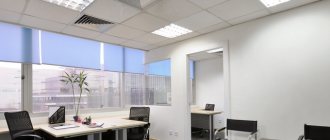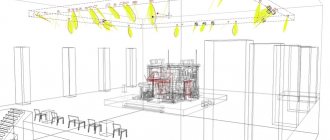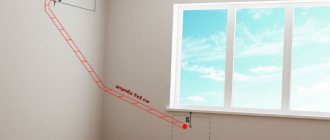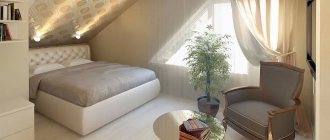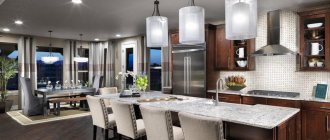Let's look at these principles and basic knowledge that should be initially applied when designing and installing lighting in the work area at work, at home, in the office.
Illumination standard
The first thing you need to focus on is compliance with lighting standards. According to regulatory documents GOST R 55710-2013 and SanPiN 2.2.1/2.1.1.1278-03, the average illumination in workplaces with constant presence of people must be at least 200 Lux.
There are also more stringent requirements set out in the European Union standard EN 12464. Here are the average illumination values for workplaces in offices from there:
How to achieve these parameters and choose the right number and power of lamps?
Of course, there are special complex programs for this (DIAlux, etc.), but if you are not a professional designer, but an ordinary user, then the calculation can be done somewhat differently and much faster.
This method is very rough and may contain errors, but is suitable for non-professional use.
Let's take the well-known formula for calculating illumination and multiply it by a correction factor.
This coefficient means the amount of light that directly reaches the illuminated surface. If you have more than one powerful directional lamp above your workplace, then it is quite natural that some of the rays from the light source will spread on all sides and not reach the work area.
Therefore, on average we will take it equal to 0.5.
That is, we will assume that approximately half of the light reaches our working surface.
Next, we measure the area of the working area. After this, we find from the passport data on the packaging or from tables on the Internet the value of the luminous flux of the selected lamp.
Substituting all this data into the formula, we get the result of the illumination that this light bulb will provide in this particular place. According to GOST requirements, you need to provide 200Lx.
Accordingly, divide these 200 lux by the result, and you will find out how many such lamps or light bulbs you need.
It turns out that in order to calculate the illumination, you need to know at least two quantities:
- luminous flux from light source
- lighting area
I repeat that this is a very rough and approximate calculation, but it is better than none at all.
To check the actual illumination after installing the lamps, special measuring instruments are used - lux meters.
Once you've achieved the required illumination, that's only half the battle. Don't forget that without regular cleaning of fixtures, walls and ceilings, it may decrease over time.
The number of cleanings of lamps per year for industrial premises is strictly regulated.
The same applies to natural light coming through the windows. Without regular glass cleaning, the illumination in any room decreases.
At the same time, when choosing the color of walls and ceilings, it is advisable to initially focus on light shades.
Don't forget that all surfaces, in addition to absorbing, also reflect light. Here are the recommended reflectances for walls, ceilings, floors and countertops.
When the material is made of dark wood or painted in dark colors, these values are reduced.
Also, you should not make contrasting and bright transitions from one color to another. Such a rainbow will not be entirely compatible with concentrating attention in the workplace.
There are of course exceptions. For example, if you have creative work, this color can of course be used, but it should be done in places that will not come into your field of vision while working.
Selecting a calculation method
Having an idea of how the calculation is made, let's look at which method to choose specifically for your case. After all, different calculation methods are intended for different rooms and conditions.
So:
- Let's start with the luminous flux utilization factor method. This method has found quite wide application. It is mainly used to calculate general lighting in rooms that do not have horizontal height differences. In addition, this method will not be able to identify shaded areas and make calculations for them.
Choosing a method for calculating illumination
- For these purposes, there is a point method. It is used to calculate local lighting, shaded areas and rooms with height differences, as well as inclined surfaces. But it is quite difficult to calculate the overall uniform illumination using this method - after all, it does not take into account reflected and some other components.
- But the power density method is one of the simplest. But at the same time, it does not give exact values, and is mainly used as an approximate one. It is used to determine the approximate number of lamps and their power.
In addition, this calculation allows you to determine the approximate cost of installation and operation of this lighting system.
Shadows
Eliminate all shadows from the work area as much as possible. The surface should be illuminated evenly, and the difference in brightness is minimal.
Constant switching of vision and the reaction of the pupil to transitions from darkened to brightly lit areas not only takes some time to adapt, but is also a hidden factor in rapid fatigue.
For example, after moving from a light room to a dark one, our eyes need more than an hour to properly adapt to the new conditions. When the process is reversed—coming out of darkness into light—it takes only 15 minutes.
Moreover, even a small difference in the amount of light and the presence of slightly darkened areas also negatively affect vision. Imagine that such changes will occur constantly during 8 hours of working time?
How does this translate at the desk? For example, you illuminated documents with directional light from a table lamp, while the monitor screen remained in the shadow. Constantly moving your gaze from papers to the display will hurt you at the end of the working day.
Therefore, the work area at the computer desk is usually illuminated with a wall lamp at a height of 30-50 cm from the monitor. It provides uniform illumination of the entire space.
To achieve good lighting and remove shadows from the work area as much as possible, you will have to experiment with the height and location of the lamps. Here it is impossible to name any one universal formula and indicate the exact distance.
Everything will depend on the specific workplace and your location in it. Naturally, the lamps should not be at eye level.
Most of the mistakes in this case are associated with the wrong choice of table lamps.
Types of lighting on the ceiling
A chandelier is the most traditional option for lighting a room, it is certainly located in the center of the ceiling, decorated with several branches or horns, the center of the room is perfectly illuminated.
Built-in spotlights or spots are mounted in suspended or suspended ceiling structures. Their main design is visually invisible, since it is located inside the finished surface of the ceiling; from the outside, only the lamp itself and its decorative design can be observed.
Illumination in the form of linear lighting devices hidden from visual view. They are mainly used on suspended or suspended ceiling structures, but a regular ceiling is also suitable for this; just make a plasterboard box. The main purpose of lighting is the aesthetic decoration of the room, but not functionality.
However, to arrange modern and stylish room lighting, you can use, in addition to those mentioned, the following types: floor lamps, wall sconces or table lamps with beautiful lampshades.
Work area
Remember that you cannot illuminate only the workplace with a sufficient number of lamps, leaving everything else in twilight. The adjacent space must also meet certain lighting standards.
For example, what is located half a meter (0.5 m) from the workplace is called the immediate surrounding area.
Here are the recommendations for illumination values for this zone, according to GOST.
Everything further than 0.5 m from the workplace is a peripheral zone. In it, the illumination should be at least 30% of the previous zone within a radius of half a meter.
This is the only way you will create normal working conditions for yourself and your employees.
Glare and brightness of light
Do not use glossy or sparkling materials on the table. When working, remove all shiny objects from your field of view.
By glare, they increase fatigue. In addition, the table itself should be made of natural, natural materials (wood).
Place computer monitors at your workplace so that direct light from a window or other sources does not fall on them. The discomfort even from reflected bright light does not go away even after finishing work.
It's like picking up “bunnies” from welding. Of course, it is not so painful for the eyes, but it significantly reduces the overall tone and performance of the entire body.
The older you are, the stronger this effect becomes.
Eliminate all sources of bright light from the work area as much as possible. If this is not possible, then install special diffusers.
A good effect is achieved by mixing direct and reflected light. This is done using open top lamps.
General and natural light
In any room where there is a workplace, there is a so-called general or main light. SanPiN rules prohibit the presence of only local lighting of workplaces.
For main lighting, the basic principle always applies - the higher the lamp, the more uniform the light.
In addition, the higher it is located above the table, the less likely it is that its rays will directly fall into your field of vision.
When arranging desk lighting, always try to make the most of natural light. No matter how perfect and versatile modern lamps are, they cannot replace solar lighting.
Therefore, if possible, arrange your furniture and desk so that these places are as close to the windows as possible. In this case, the window should not be directly in front of your face or directly behind your back.
By the way, do not forget that natural light in buildings can be not only lateral, but also overhead.
Even at the stage of designing and planning repairs, it is advisable to make windows as wide as possible and place them at the maximum possible height.
Natural light in a room has its own coefficient - KEO. It is calculated based on the ratio of illumination in the building to the illumination on the street (in bright sunny weather).
KEO also depends on where in the world the building is built. After all, in southern latitudes, natural illumination is much higher than in northern latitudes. To calculate KEO there are special maps divided into several zones.
In addition to its positive impact on health, natural light also reduces your electricity costs and the operating time of the lamps themselves, extending their service life.
Which lamps to choose
According to all the latest trends and studies of the impact on our body, ideal light sources for the workplace can be arranged in the following sequence:
- LED
- luminescent
- halogen
- regular incandescent light bulbs
LED lamps have long been the undisputed leader.
Switching to their basis not only gives a good economic effect, but also reduces the harmful effects of improper light on the body. The pulsation coefficient in them should not exceed 10%.
Halogen ones can also be a good option in some cases, but their heating temperature significantly limits their areas of application.
Also, all lamps, regardless of their type, must have the same color temperature with a color rendering index CRI of more than 80.
As for individual lamps, they must be selected under two conditions:
- ability to adjust the direction of light
- ability to change intensity and brightness
Additional requirements
Light is characterized not only by intensity. Other parameters can significantly affect a person’s vision. It is known that any light source pulsates at a certain frequency during operation. If the frequency is such that it is captured by the visual system, and this is less than 300 Hz, then it can affect concentration, impair vision, cause headaches, and distort the image. Therefore, the ripple rate should not exceed 5%.
Light has the ability to reflect from surfaces, and not only from glossy ones. Any surface has a reflection coefficient and this is also taken into account when organizing the lighting. The standards for reflectance are:
- work surface or table - 0.2–0.7;
- walls - 0.3–0.5;
- ceiling - 0.6–0.8;
- gender - 0.1–0.4.
